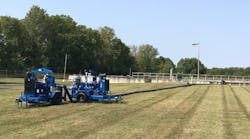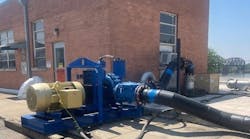Sand, grit and air can cause degradation in the accuracy of mechanical meters. There is such degradation in areas where the quality of water is high. However, the loss of accuracy occurs significantly faster when water from boreholes or sugar sand—a fine silt found in states including Florida, New Jersey, Michigan and California—is commonplace. Accuracy loss begins soon after installation and can result in progressively large revenue losses for water utilities.
As an alternative to mechanical meters, water authorities worldwide are using SmartMeter water meters from Severn Trent Services . Incorporating fluidic oscillation technology, the water meters are designed to overcome the problems caused by particulates that plague mechanical meters. The no-moving-parts design ensures metered flows and income remains accurate over the entire product lifetime.
The village of Tinley Park, Ill., a municipality that receives its water supply from Lake Michigan—high-quality water that is low in particulates—conducted a cost-benefit analysis of its system. Using theoretical data to reflect anticipated lost revenue over a three-year period from the village’s nearly 14,000 mechanical meters, the village projected a minimum total loss of revenue of more than $1.4 million—higher than the cost to replace all meters.
The village elected to replace the entire installed base of mechanical meters with SmartMeter water meters over the following three years. One year after this decision, all the meters continue to show consistent revenue recovery.
The presence of sand, grit and air in the water supply is not only a problem in the U.S. In other parts of the world, these issues are a constant problem affecting the working life of existing mechanical meters.
In Egypt, collection for consumption was becoming increasingly difficult. Even where bills were paid, there was an obvious decline in income as meters began to under-record or fail completely. Before choosing the Severn Trent Services system, the Egyptian Utilities, sponsored by a U.S. Aid project team, had examined a number of options, all of which were too expensive or unworkable in local environmental conditions.
A further impetus to the need for a new metering solution was the Egyptian decision to introduce prepayment into the system, which would in theory provide a partial solution to the revenue collection difficulties. However, the practicalities were not so straightforward. Apart from the logistics of moving from monthly billing to a prepayment system, the constant problem of air events in the system prevailed. When such events occur, mechanical meters can register erratically, consuming prepaid credits and quickly destroying the meter.
This problem was addressed by introducing SmartMeter solid-state metering technology. The technology has an automatic metering system that allows both credit and prepayment systems to operate simultaneously. Customers can be switched—remotely by the utility—between payment method options, depending on their payment record. The payment record of each customer is monitored by the system manually or by direct debit, eliminating the need for expensive smart card systems that require equipment maintenance and the creation of card charging sites.
In the United Arab Emirates, the Abu Dhabi Water and Electricity Authority (ADWEA) elected to use the SmartMeter when upgrading its water metering technology. SmartMeter solid-state water meters have been specified by ADWEA to replace existing mechanical meters, allowing the utility to meet its requirement of improving metering accuracy and reliability.
Through customer usage and independent laboratory tests, SmartMeter water meters have been proven to prevent losses in water metering revenue caused by progressive meter inaccuracy. In one independent test, 14.5 million gal of water were passed through the meters to prove their accuracy. Typical payback of meter installation is roughly three years, depending on the cost and quality of water available.


